Shoes with these devices must be worn constantly, the height of the heel should be 1-3 cm.
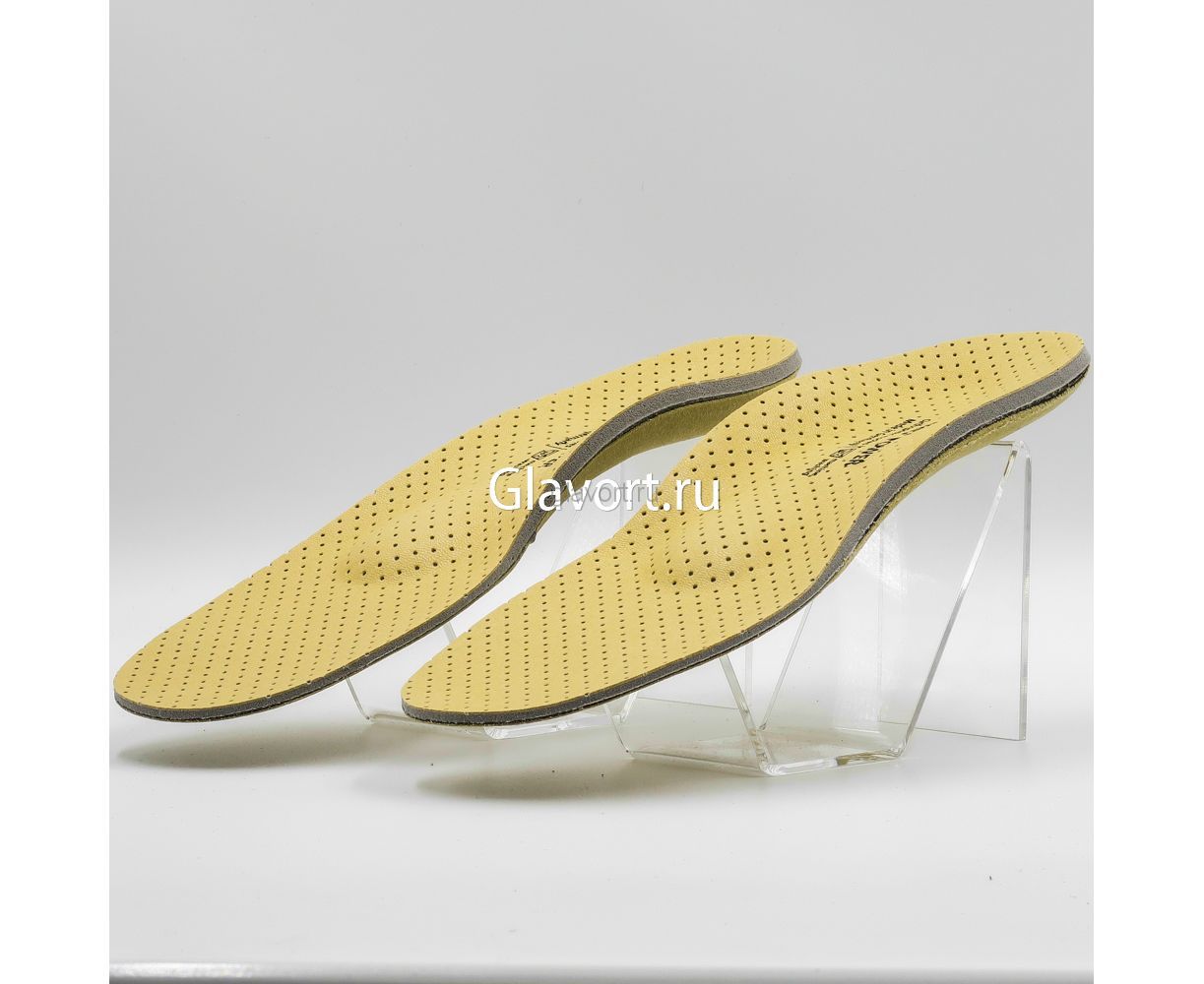
- How to correct flat feet in a child?
- What are the risks of foot deformities?
- brand
- types and prices
- A healthy and balanced diet
- CONTACT
- Bykov insoles - a unique remedy for flat feet
- Suspended shoe inserts - materials, composition, effect
- Video about supinating insoles:
- What is the difference between custom made insoles and regular factory made insoles?
- What is the difference between Amfit and Extempo insoles?
- How long do I need to use and care for the custom insoles?
- Can custom made insoles be used in fashionable women's shoes? What shoes can they be used on?
- What is the adjustment time for custom insoles?
- customer feedback
- classification
- diagnosis of the problem
- symptoms
- Causes of heel spurs and risk factors:
- Tips for care
- Manufacturer
- Features of device construction in shoes for sports activities
- This is how orthopedic sports insoles work:
- How to choose the right model?
- Trives sports insoles.
How to correct flat feet in a child?
The change in the arch of the foot is diagnosed late due to the peculiarities of the child's leg development. The attentive attitude of parents and the pediatrician makes it possible to identify flat feet in the child in time and plan ways to solve the problem. It is important to remember that childhood flat feet are a serious pathology that can cause irreversible changes in the body.
The cushioning function of the foot is to protect the musculoskeletal system, the brain and spinal cord, and internal organs from shock when walking. The coordinated action of the muscles, ligaments, tendons and bony structures of the foot allows for the distribution of body weight in all movements.
The physiological characteristics of the foot, such as B. the arch of the foot, are responsible for its shock-absorbing function. The arch of the foot is divided into two main areas:
The foot is held in the correct position by well-developed ligaments and muscles.

Flat feet change the pivot ratio. As a result, the foot rests on the entire plantar surface.
The normal support function is taken over by the heel, the 1st and 5th metatarsal bones.
What are the risks of foot deformities?
Symptoms of flat feet in infants are often hidden by a layer of dermis, and infants and children under one year old do not have a foot curvature. The foot doesn't form until the age of 4 to 5, and by that time it's clear there's a problem.
The development of flat feet has the following consequences:
- deformation of the foot;
- degenerative processes in the ankle;
- curvature of the spine in the form of scoliosis with consequent changes in the structure of the pelvis and the functioning of the organs located there;
- osteochondrosis;
- Increased intracranial pressure;
- The elasticity of the vein walls is disturbed and varicose veins develop;
- occurrence of heel spurs.
These changes occur as a result of disease progression with flat feet in adolescents.
brand
- biomag
- comforma
- Corby
- Forta
- luomma
- Ortman
- Orto
- Ortho professional
- OrtoLab
- Otto Bock
- pedag
- school
- shoe boys
- talus
- timed
- argon
- trives
Buy orthopedic products for comfort and health offers the online store 'Kind Orthopedist'. We deliver orders to St. Petersburg and other cities, guarantee 100% product quality.
Orthopedic insoles are special devices that relieve the foot, correct it and fix it in a physiologically correct position. They take the form of spinners, small shoe inserts that relieve pressure on the feet. The insoles support the longitudinal arch of the foot.
types and prices
Specialized medical insoles are used not only to prevent and treat foot problems, but also for abnormalities such as different leg lengths. It is also recommended to buy and use these orthotics for flat feet. Order goods in St. Petersburg with free delivery throughout the city.
The catalog offers a wide range of products, including: longitudinal, transverse, longitudinal-transverse, children's, semi-supinator, models for women who prefer a low heel, etc.
Strictly according to the medical requirements:
The use of perfectly fitted insoles (after consultation with the doctor) leads to:
- Improved foot function;
- Reducing foot fatigue and pain
- prevention of shoe deformities;
- Correct formation of the arch of the foot;
- Avoiding flat feet.
Size, equipment, purpose and price - the selection of products is very large. In our store you can buy orthopedic insoles quickly and cheaply.
Our consultants in the Good Orthopaedist online store will help you make the right choice.
A healthy and balanced diet
It is important that you watch your weight. The extra weight puts all your joints and feet to the test. They can no longer withstand the extra pressure and begin to flatten out. Everyone knows the rules of healthy eating, but we would like to remind you of a few points.
- Include more vegetables, fruits and berries in your diet.
- Pay attention to the benefits of fiber for the body.
- Introduce foods rich in calcium, vitamins and trace elements.
- Take vitamin D prophylactically in the sunless seasons.
- Do not stick to mono diets or fixed diets. The body should receive a varied and balanced supply of all vitamins and essential macro and micronutrients.
It is important to form a muscular corset in time to support the spine and strengthen the ligaments and muscles in the legs. Systematic movement is required for this purpose. Orthopedists recommend the following types of physical activity:
- Training on machines - in particular elliptical trainers, treadmills;
- Visiting a swimming pool – water aerobics, swimming (especially types of swimming that involve kicking);
- To go biking
- To ski
- outdoor walks;
- jumping jacks;
- Walking slowly with the foot on a springy toe.
At the same time, overexertion and overuse damage all joints. Therefore, people with a predisposition to flat feet should avoid weightlifting, athletics, and long hikes.
orthopedic supports
Many people believe that special orthotics, bandages and other supports are only necessary if they have this condition. This is a misconception. Orthoses in particular help the feet to stay healthy in certain situations and stages of life. What should I put attention on?
- Pregnant women have an increased risk of getting flat feet. Your shoes should be as comfortable as possible, made of quality material, have orthopedic insoles and fit well.
- A fracture (injury) of the ankle, the foot itself and the toes require the use of gel insoles, supinators and custom-made orthoses.
CONTACT
For complete information on the treatment and prevention of orthopedic, rheumatological or neurological diseases, please contact us:
 Tel. +7(495)120-46-92
Tel. +7(495)120-46-92
 Email: [email protected]
Email: [email protected]
feedback form  Send us a message on Telegram
Send us a message on Telegram  Contact us on WhatsApp
Contact us on WhatsApp

Our address is 11 Trifonovskaya St., Moscow, Russia.
Bykov insoles - a unique remedy for flat feet
Trainer's insoles restore flat feet and keep them in normal condition
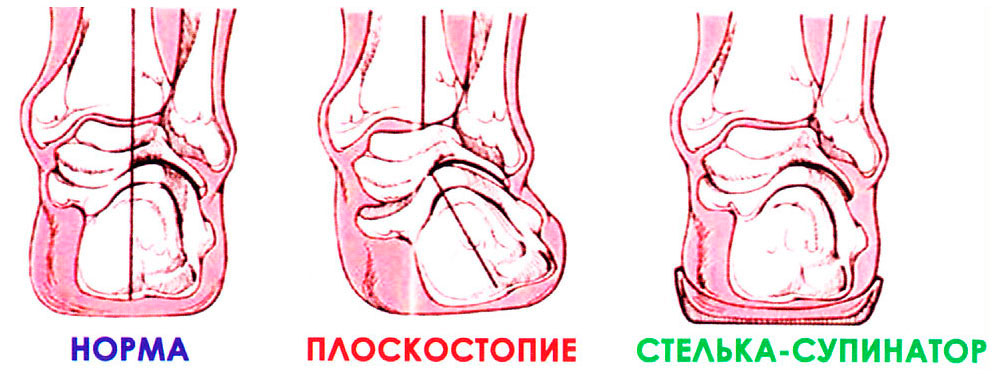
Vitaly Martynovich Bykov insoles made of flexible and strong material act as a kind of trainer, forcing muscles and ligaments to work continuously, restoring their lost properties. Flexible like a wave, the insole bounces up and down, activating the muscles and ligaments of the foot. Their activity normalizes blood circulation in the limbs. The supinator supports the arch of the foot, improves stability when standing and walking, massages the plantar surface, prevents foot fatigue, reduces pain when walking, improves general health, prevents the development of pathological conditions of the musculoskeletal system - the consequences of flat feet . And in childhood and adolescence, comprehensive treatment and specific exercises can significantly improve the condition of the foot until it recovers. A unique 'corset' that helps relieve heel spur pain.
Suspended shoe inserts - materials, composition, effect
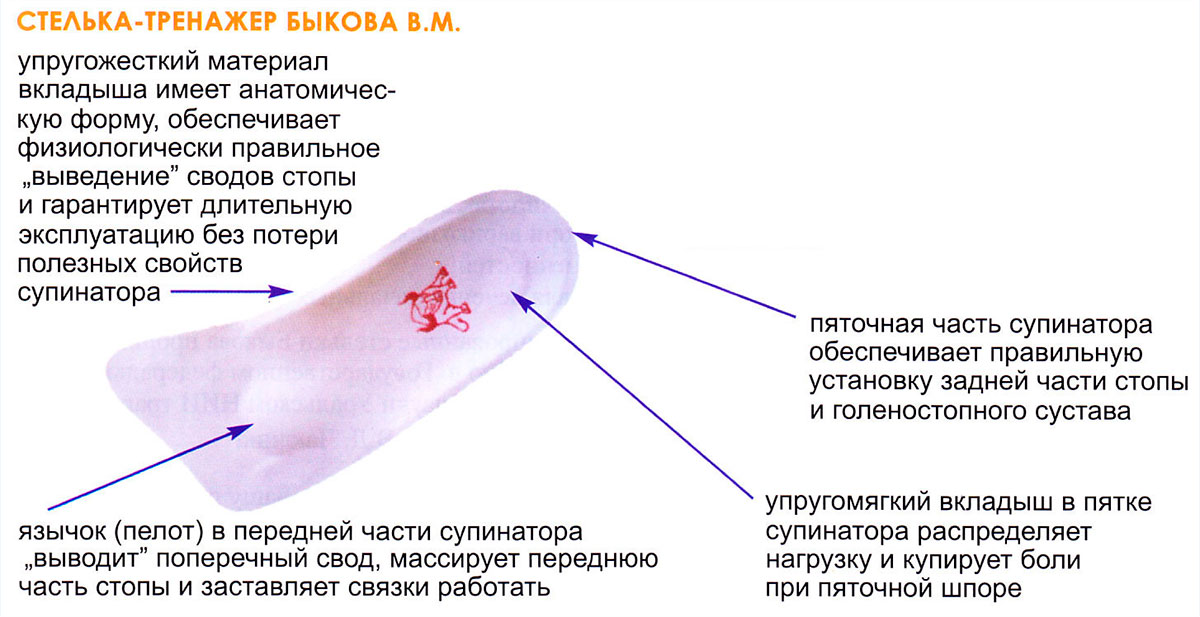
Supine pads are great for preventing and treating the following conditions:
- heel spur
- neuromas
- calluses
- tendovaginitis
- corns
- bursitis
- Toe and forefoot deformities
- Diabetic foot
- osteochondrosis
- disc prolapse
- radiculitis
- contortions
– scoliosis
– kyphosis - sciatica
- back muscle fatigue
- back pain
Diseases of the knee joint:
- Deforming arthritis of the knee joint
- inflammation of the meniscus
- Synovitis - Accumulation of fluid in the joint
- Sprained knee ligaments
Video about supinating insoles:
Bykov insoles (inventor's statement)
Orders can be placed online
24 hours a day, 7 days a week
- Free consultation with an orthopedic doctor.
- Collection of the anamnesis, examination of the feet and the spine.
- Examination with the digitizer and creation of a foot model.
- Production of individual insoles.
- Advice from the doctor
What is the difference between custom made insoles and regular factory made insoles?
A custom insole is an impression of your foot. Their shape reflects the anatomy of a human foot. Therein lies the secret. Such insoles are not only good for your health, they are also very comfortable.
What is the difference between Amfit and Extempo insoles?
Amfit insoles are custom-made using a unique 3D computer-aided modeling system to ensure a perfect and very accurate fit to the foot with the best possible medical effect. They are made of a very durable material, have a high abrasion resistance and do not shrink. An adjustment is not required. The insoles can be up to 2mm thick and are available in sizes 25 to 50.
How long do I need to use and care for the custom insoles?
A pair of custom-made insoles usually lasts 6 months for children (since children's feet grow quickly) and up to 2 years for adults. If they get dirty, the insoles can be cleaned with a damp cloth. They should not be dried on heaters.
Can custom made insoles be used in fashionable women's shoes? What shoes can they be used on?
They are suitable for most types of shoes, but with a heel of no more than 6 cm (otherwise the therapeutic effect would be lost). When making the insoles, we take into account what footwear you wear more often, how much you stand and walk.
What is the adjustment time for custom insoles?
The maximum adaptation time is two weeks (for complex defects). When using insoles for the first time, it is usually about a week.
customer feedback
Overall my impressions are not bad. I consulted an orthopedist about flat feet. The doctor was very attentive, examined me, answered all my questions and advised me to wear orthotics. While I didn't order any right away, I probably would because there was little other way to fix the problem and I don't think he just wanted to bend me over. He seems to be a very decent and honest man. I have not experienced anything negative and can recommend this clinic.
I would like to thank the wonderful doctor very much. He is a professional with a big letter and is able to communicate with any patient. I would also like to thank him again for his good advice on rehabilitation after the fracture.
I would like to thank Albert from the bottom of my heart for his professionalism in allowing me to regain full mobility after my hip replacement surgery and all the other medical and technical staff involved in my treatment. May God grant you good health and success in your hard work.
I would like to thank the staff at Master of Feet for their incredibly courteous service. I was competently and accurately offered the necessary product, without intrusiveness, a medical consultation and tactfully answered all the questions that interested me. I came for the silicone band recommended by the doctor. I left the practice with orthotics, bondage, magic cream and a reference card for my wife. A pleasant surprise – everything really works. Good luck to you, the workshop staff, and good luck to us customers!
I went to see a Master Legs doctor a week ago - I really enjoyed it. I had Amfit insoles made after previously using standard insoles. I can already feel a big difference - thanks to Master Legs! I will bring my children to the Lord soon!
I have no problems with my feet, my friends ordered the insoles and the effect has exceeded all expectations! His back no longer hurts and his feet no longer hurt and sweat. I'm very happy with him and now I know who to turn to if anything happens.
classification
Depending on the severity of the anatomical changes and the clinical symptoms, longitudinal foot can be divided into the following categories:
- Grade I - manifested by a slightly pronounced deviation of the arch of the foot, the height of the arch varies between 25 and 35 mm. (considering that the normal height for an adult is 35-40mm, for a child under 7 years old it is 19-24mm). It is accompanied by fatigue after a long load on the legs, at the end of the day there may be swelling of the distal area and slight pain when palpating;
- Grade II - moderately severe flatfoot is characterized by a reduction in arch height to 17-24 mm. There is severe pain and swelling of the lower limbs, the arch of the foot is lowered, mobility of the steps is impaired, pressure on the feet is painful and causes discomfort;
- Grade III is a pronounced flatfoot with an arch height of up to 17 mm. Persistent leg pain is accompanied by lower back and knee pain. Osteochondrosis, knee arthrosis and other diseases of the musculoskeletal system occur. The ability to work and walk is restricted. Wearing normal shoes becomes impossible.
With timely treatment, the disease can be prevented from developing into a very serious condition. Therefore, if symptoms are detected, the patient should immediately consult a podiatrist.
diagnosis of the problem
The diagnosis of flat feet can be made on the basis of the medical history, physical examination, certain tests, podometry, planimetry and x-rays of the feet.
The Friedland podometric calculation method is used to measure the foot, make calculations and determine the rate of progression of the disease.
Plantography consists of an examination in which the sole of the foot is stained and an impression is made on a piece of paper.
The radiograph is performed in lateral projection. This position allows the radiologist to calculate the angles and distances between the bones.

Fill out the form and we will contact you
symptoms
The pain is often like the feeling of a nail or needle in your heel and is especially severe in the morning. When walking, the pain becomes less severe or disappears completely. However, if countermeasures are not taken, the pain can become chronic and almost constant, affecting not only the inside of the heel but the entire heel area.
As the disease progresses, the pain increases after long-term stress on the feet. The intensity of the pain depends not so much on the cause of the condition and the size of the 'spur', but on its location in relation to the heel. If the spur is near the nerve endings, the pain will be stronger. The pain can also be triggered by sudden support in the heel area, such as getting out of a bed or chair, or climbing stairs.
Sometimes the heel spur is asymptomatic, but there is also inflammation and the bony 'tip' is discovered by the doctor during an examination.
When inflammation of the plantar fascia is added, the following reactions occur:
- A tingling and burning sensation in the heel area;
- reddening of the skin on the affected area and thickening of the skin;
- Painful sensations that worsen with movement.
Over time, the affected person gets used to the pain syndrome and unconsciously changes his gait. When walking, the foot positions itself to relieve pressure on the affected area, supporting itself on the dorsum and lateral surface of the foot. Sometimes this can also be one of the causes of longitudinal flatfoot, which further aggravates the situation.
Causes of heel spurs and risk factors:
- overweight. Being overweight increases the stress on the feet, the fascia becomes overstretched and tears, leading to inflammation at the microfracture site, creating a 'spur'.
- Pregnancy. Hormonal changes occur, ligaments become more elastic, the arch of the foot becomes less elastic and flattens, the center of gravity shifts, leading to abnormal load distribution and overstretching of the fascia.
- Older age. After the age of 50, metabolism changes significantly, blood circulation in the lower limbs can deteriorate, ligaments become more susceptible to micro-injuries, and the risk of salt deposits increases.
- Longitudinal flatfoot, which results in abnormal load distribution and increased pressure on certain parts of the foot, leading to tearing and inflammation of the fascia and subsequent spur formation.
- Chronic joint and skeletal diseases, acute injuries to the spine or lower limbs, diabetes and taking hormonal drugs to treat these problems lead to an increased risk of spur formation as a result of abnormal load distribution in the feet or a disturbed metabolism with excessive deposition of calcium salts.
- Inappropriate footwear (narrow, tight, thin flat soles, etc.) which increases the risk of flat feet and the associated complications of heel pain.
- Occupations that require long periods of standing or heavy lifting on a regular basis (sales assistants, hairdressers, waiters and most physical occupations) and competitive sports. These factors lead to increased stress on the feet and increase the risk of overstretching the plantar fascia and its microdamage with subsequent inflammation.
- Hereditary factors increase the risk of predisposition to diseases that can lead to 'bony spikes' in the heel area - flat feet, joint diseases, diabetes, obesity, etc.
Tips for care
In order for shoe inserts to last a long time, they must be properly cared for. A basic rule for all insoles is not to wash or dry them in the washing machine and not to use harsh detergents. The hygienic treatment depends on the material:
- Leather soles should be cleaned with a soft cloth dampened with a soap or alcohol solution diluted to 20 % water. Be careful not to saturate the surface with moisture. Take the insoles out of your shoes every evening and air them out.
- Rubber, silicone and plastic are waterproof and can be rinsed off with warm water and mild detergent.
- An insole with a textile surface must be hand washed and air dried regularly.
Odors can be eliminated by treating the top layer with a special antibacterial impregnation agent. Disinfection is allowed up to 3-4 times a week.
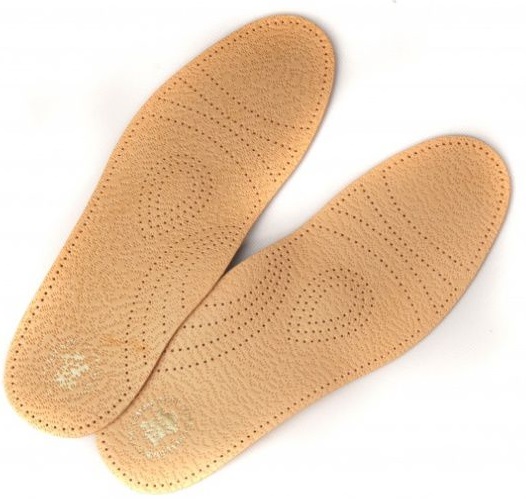
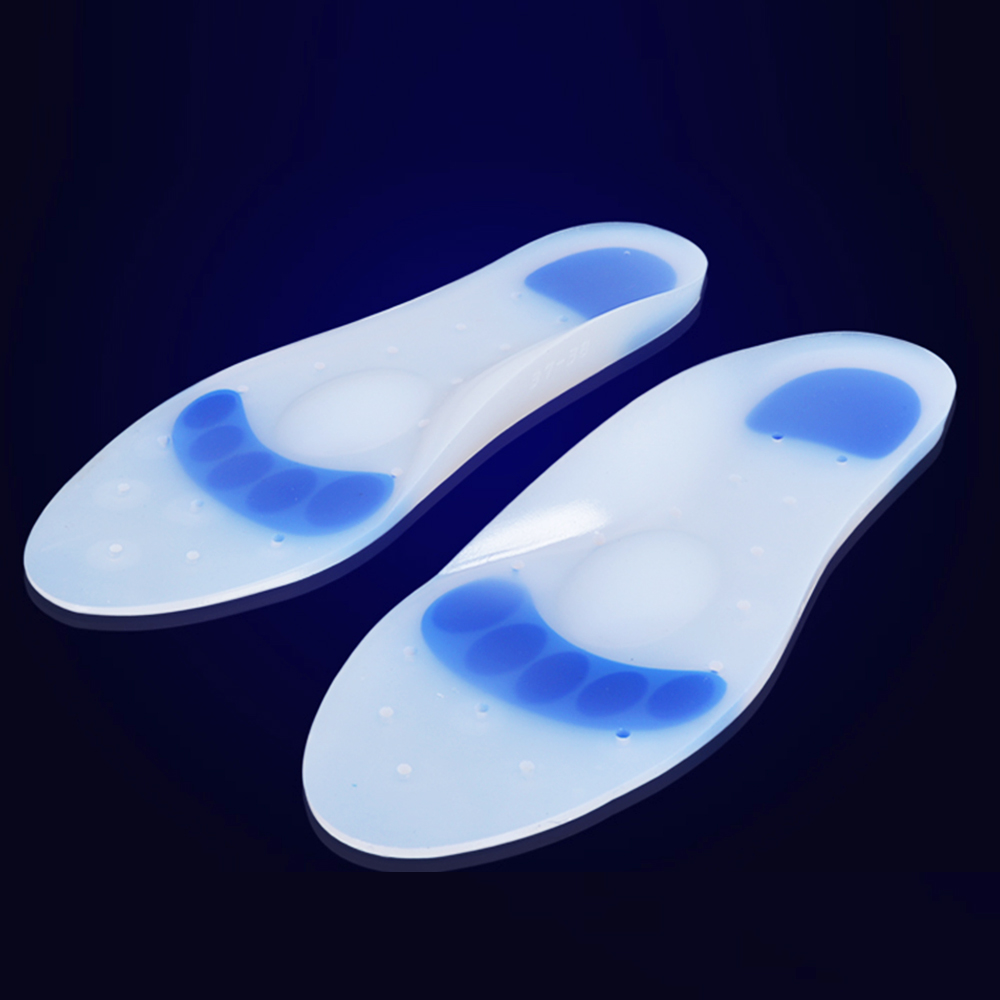
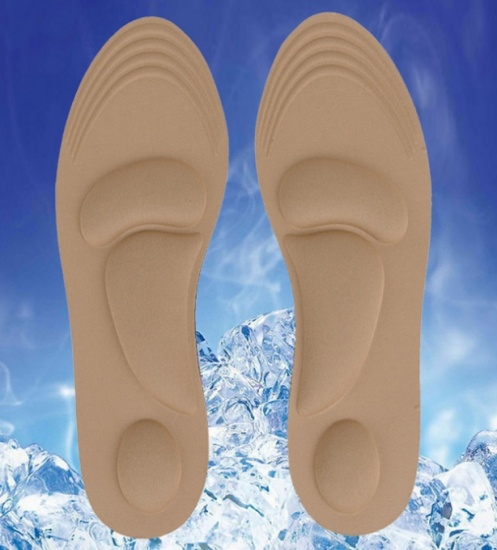
Manufacturer
In order for insoles to last a long time, it is worth ordering custom-made products or buying good quality insoles from reliable brands. Also pay attention to the designs of the following manufacturers:
- Ortman. A European brand specializing in the prevention and treatment of foot diseases and deformities. The company manufactures footbeds made from polymeric materials, abrasion-resistant textiles and supple leather.
- talus Russian brand that produces frames and soft orthopedic insoles for women, men and children. Made from high quality imported materials such as regenerated leather and silicone.
- Pedag (Germany). Has been making insoles for more than 50 years. The company uses environmentally friendly materials such as vulcanized latex and natural leather that has not been chemically treated. These products are recommended by leading orthopedic surgeons in Europe and the United States.
- Ortho. The Russian manufacturer produces foot correctors, winter and summer models of orthopedic insoles with pads for all ages.
St. Petersburg-based brand Trives has been manufacturing medical products and orthopedic insoles for more than 25 years. It is one of the leading brands in Russia. The company has received the Global Industry 2015 and other prestigious awards. The catalog offers a wide range of products, from gel foot suppinators to children's orthopedic shoes, massagers, trainers and rehabilitation equipment.
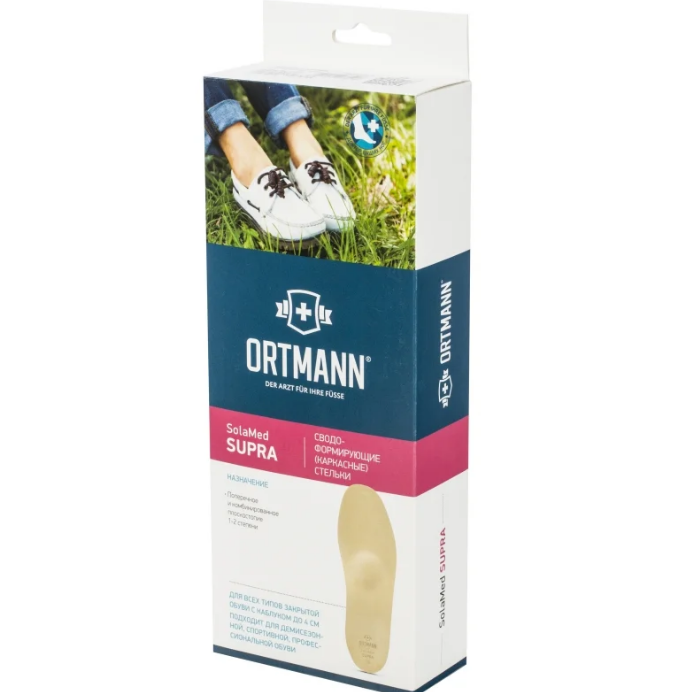
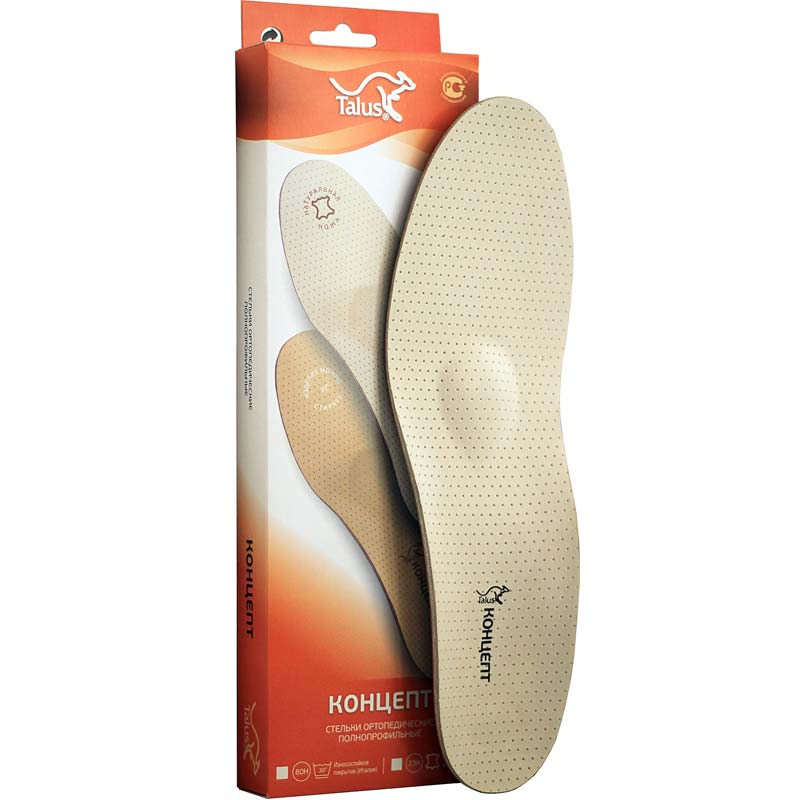
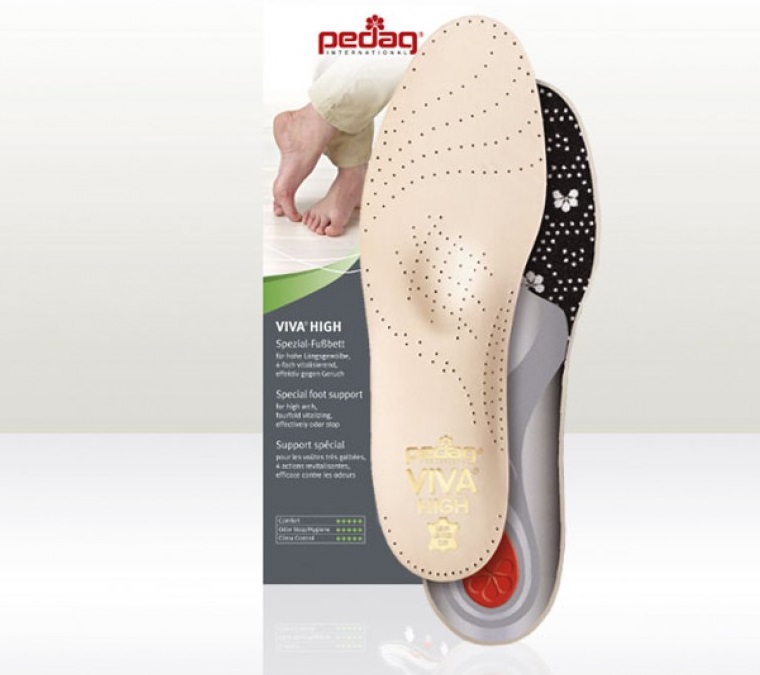
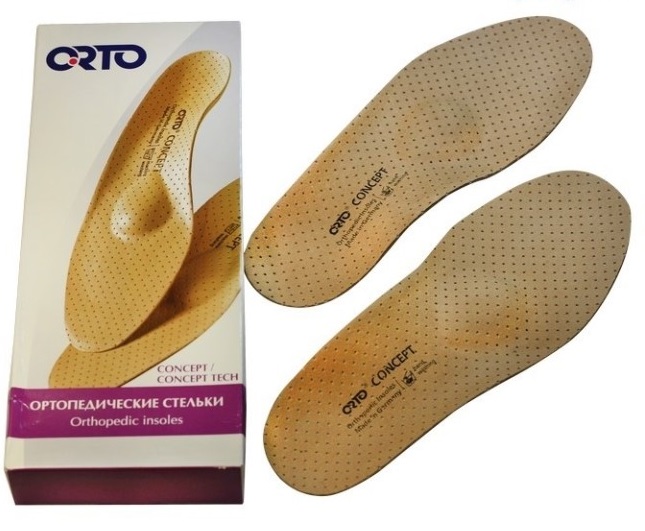
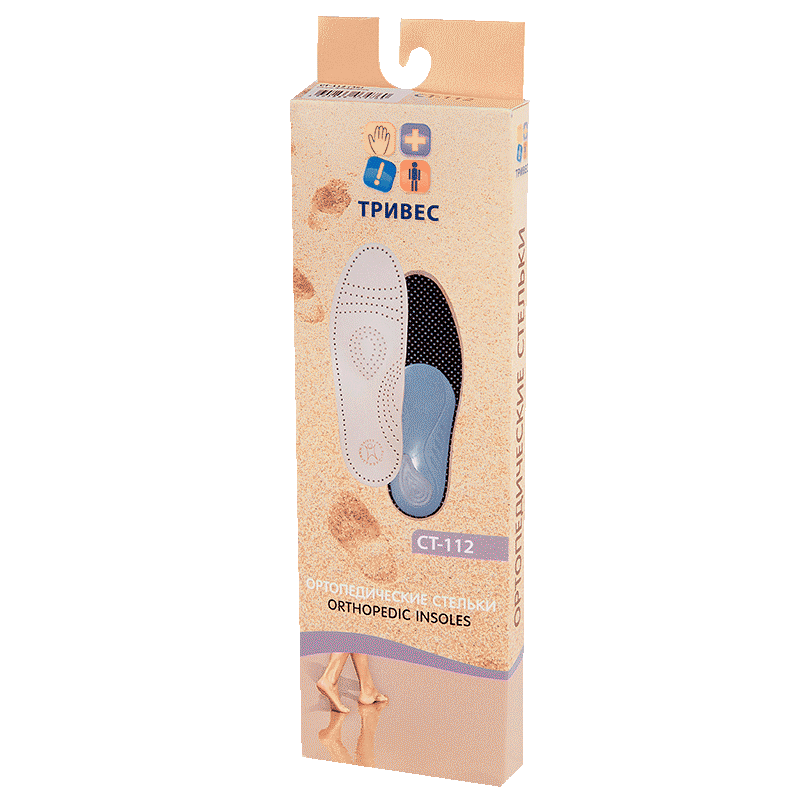
Features of device construction in shoes for sports activities
When developing anatomically correct footbeds, manufacturers take into account the positioning of the foot in sports shoes and the fact that the joints are subjected to increased stress at this point; this must therefore be compensated for by special zones and product features. The insole for sports shoes differs in its structure from conventional products.
The insole is physiologically correct and takes into account the special characteristics of the foot. It can be made of polyurethane or latex foam, silicone, a plastic frame or a multi-layer construction. It enables cushioning properties that are important for absorbing impact loads on the foot. Additional components also contribute to this. To adapt perfectly to the shape of the foot and the durability of the product, the insole combines flexibility and durability.
A sports insole can consist of the following components or combinations thereof:
- Lateral or metatarsal pads relieve the forefoot by distributing pressure, support the transverse arch and prevent the foot from slipping in the shoe. This is an essential product for runners, long distance runners and people with transverse flatfoot or valgus' on the first toe;
- heel padding. The flexible cushioning element reduces excessive stress on the heel;
- Cupped heel. Cupped heel padding. Special construction in the heel area stabilizes the heel in an anatomically correct position;
- Massaging element. It is located in the forefoot area and is used to stimulate the foot muscles.
Physical activity is associated with excessive sweating. It is well known that a humid environment is a favorite breeding ground for bacteria and fungi. Therefore, the sports insoles have bactericidal and fungicidal properties, good moisture absorption and hypoallergenic materials to ensure good moisture and heat exchange and protection against bacteria and fungi. The perforated products allow effective air circulation.
This is how orthopedic sports insoles work:
- Positioning the foot in a physiologically correct position;
- Support the arch of the foot;
- minimizing the stress on joints and spine;
- redistribution of loads on the foot and joints;
- Improve blood circulation in the feet;
- Protection against blisters and corns, fungi and bacteria;
- Creates a comfortable environment for the feet.
Suitable for all shoes with a closed heel: sneakers, sports shoes, cleated shoes and even boots and moccasins. It depends on which shoes you feel comfortable in during physical activity. For long walks, for example on the way to and from work, many people prefer loafers because of the strict dress code. Running is comfortable in running shoes, but mountaineering is better in shoes. In any case, physical activity puts a strain on the lower limbs, which is why it is worth adding sports insoles to your shoes.
How to choose the right model?
Some of the best-known manufacturers are Trives and Pedag, which produce sports insoles that comply with orthopedic regulations, provide comfort and are made of ecological and safe materials. The variety of models allows you to choose the best individual foot aid for professional athletes and outdoor enthusiasts.
Trives sports insoles.
Of course, customized insoles are the best option. CAD/CAM premium insoles are ideal for sports activities. They are made based on precise digital foot scans, examinations and recommendations from podiatrists. The base of the insole is made of high-quality, cushioning European EVA material, and relief zones made of softer material are incorporated into the heel and toe joints, which further reduce the cushioning load on the joints and ligaments.
For maximum foot comfort, the ST-174 is a premium insole. The uniqueness of this model lies in its construction: the base is made of polyurethane foam, inside which there is a plastic frame to minimize the stress on the joints and spine. The heel straps stabilize the heel well, while the massage elements in the front part of the product stimulate the muscles and improve blood circulation. As a result, the foot is physiologically correctly aligned and functions as it should without splaying or tipping to one side. The shin muscles and Achilles tendons are not overloaded, which reduces the risk of injury. Orthopedic sports insoles ST-174 are covered with microfiber - a hypoallergenic material that ensures adequate air and moisture exchange. This model is an excellent choice for overweight and pregnant women, as it is suitable for shoes with overpronation.
Read more:- Orthotics for flat feet.
- Supinators for children.
- Buy insoles for flat feet.
- Shoes for flat feet.
- shoulder supinators.
- What does the insole of a child's shoe look like?.
- The insole of your shoes falls off.
- flat feet (valgus foot).
